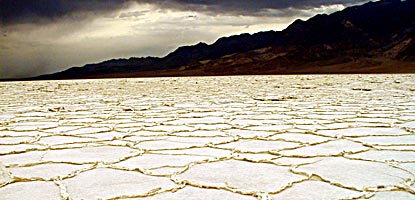The first non-Native Americans arrived in Death Valley in 1849 looking for a shortcut to the California gold fields. Although only one member of their party died, the name Death Valley was given to the area. Various mining operations used the valley afterwards, most notably for borax mining.
They say hottest, driest, lowest place in North America. In this below-sea-level basin, steady drought and record summer heat make Death Valley a land of extremes.
We spent a day at the Furnace Creek Interpretive Center and it was amazing. They had a museum depicting everything about the Valley and educational movies on every thing in the Park.
In one area called The Racetrack, Nasa says - In a particularly parched region of an extraordinary planet, rocks big and small glide across a mirror-flat landscape, leaving behind a tangle of trails. Some rocks travel in pairs, their two tracks so perfectly in synch along straight stretches and around curves that they seem to be made by a car. Others go freewheeling, wandering back and forth alone and sometimes traveling the length of several football fields. In many cases, the trails lead right to resting rocks, but in others, the joyriders have vanished. We couldn't get there in our low car but the movie was amazing.
Scotty's Castle

Badwater Salt Flats

The salt flats in Badwater Basin cover nearly 200 square miles, among the largest protected salt flats in the world coming from Death Valley’s drainage system of
9,000 square miles—an area larger than New Hampshire. This is 282' below sea level, the lowest point in the U.S.
The slat flats, are made of Sodium Chloride ( table salt ) calcite, gypsum, and borax. Salt flats are too harsh for most plants and animals to survive, yet are quite fragile. Delicate crystals are easily crushed and the relatively thin upper crust of salt can break through to the mud layer below, leaving tire tracks and even footprints. For this reason, vehicles are prohibited off established roads in Death Valley.
The slat flats, are made of Sodium Chloride ( table salt ) calcite, gypsum, and borax. Salt flats are too harsh for most plants and animals to survive, yet are quite fragile. Delicate crystals are easily crushed and the relatively thin upper crust of salt can break through to the mud layer below, leaving tire tracks and even footprints. For this reason, vehicles are prohibited off established roads in Death Valley.
The vast, surreal salt flats of Badwater Basin change constantly. Salt Crystals expand, pushing the crust of salt into rough, chaotic forms.
Newly formed crystals ooze between mud-cracks, sketching strange patterns
on the surface of the salt flat. Passing rainstorms wash off windblown
dust and generate a fresh layer of blinding white salt.
Floods create temporary lakes that dissolve salts back into solution, starting the process all over again.
As you may have gathered by now, you could spend weeks visiting this vast area.
There is Artist's Palette Drive, a scenic loop through multi-colored volcanic and sedimentary hills.
Floods create temporary lakes that dissolve salts back into solution, starting the process all over again.
As you may have gathered by now, you could spend weeks visiting this vast area.
There is Artist's Palette Drive, a scenic loop through multi-colored volcanic and sedimentary hills.
You would want to see the canyons, sand dunes, wildrose charcoal kilns used in mining, 20 mule team borax area and so much more.



No comments:
Post a Comment